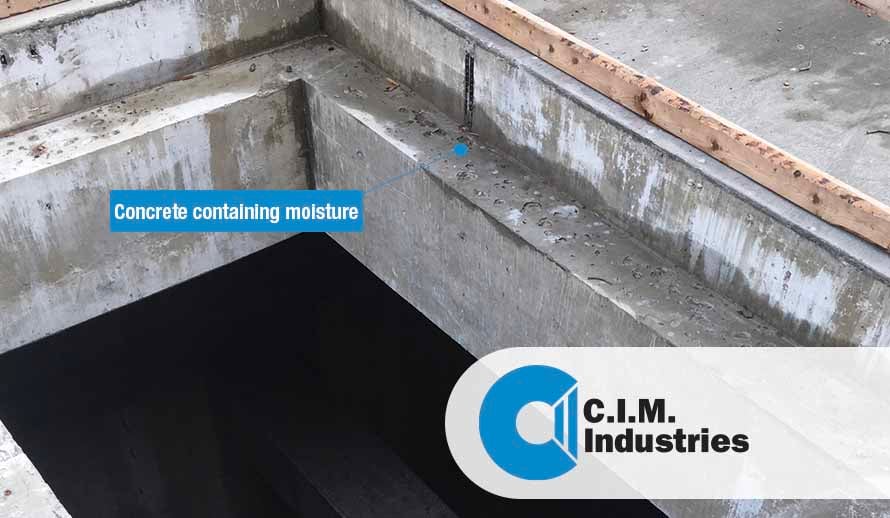 There's no avoiding the fact that concrete contains moisture, yet a critical component for successful adhesion of a coating system to a concrete substrate is having a dry substrate. Knowing how to test for moisture and addressing the conditions causing it are things all contractors should familiarize themselves with before applying coatings. Consulting with the coating manufacturer and reviewing the manufacturer's technical data sheets are excellent ways to gain this information.
There's no avoiding the fact that concrete contains moisture, yet a critical component for successful adhesion of a coating system to a concrete substrate is having a dry substrate. Knowing how to test for moisture and addressing the conditions causing it are things all contractors should familiarize themselves with before applying coatings. Consulting with the coating manufacturer and reviewing the manufacturer's technical data sheets are excellent ways to gain this information.
Preventing Moisture in Concrete
Moisture comes from various sources, including water trapped within the substrate, precipitation, and atmospheric humidity. A common cause of surface moisture often occurs when the air temperature and relative humidity rise, and the dew point temperature also increases. Moisture in the air condenses when the dew point temperature is equal to or exceeds the surface temperature; at this point, water from the air will condense on any surface where it is not readily absorbed.
 |
| Image: Moisture in Concrete |
Porous surfaces can also absorb and contain moisture at levels that may inhibit good adhesion. The water source in these substrates can come from the environment (dew, rain, snow, etc.), from moisture driven or wicked up into the substrate from the ground (water table), or vapor drive.
It is essential to address the source of moisture to prevent moisture-related waterproofing failures. Failure to adequately address and treat the concrete can result in poor adhesion, blisters, bubbling, and the coating system's debonding. To minimize the risk of applying a coating when surface condensation may be present, monitor the environmental conditions, and verify that the air and substrate temperatures are higher than 5°F above the dew point. For example, if the air and substrate temperatures are 10°F above the dew point and then start to drop to a difference of 6°F, this is generally a good time to stop the coating application to avoid surface moisture contamination.
There are multiple ways to reduce the risk of coating failure due to surface moisture, including
- testing porous surfaces for moisture content,
- applying during times of extended good weather to minimize the chance of precipitation,
- using dehumidification systems, and
- not applying coatings when surfaces are visibly wet or contain damp spots.
Related article: Documenting Your Coating Application Is Important!
Testing for Moisture
 |
| Image: Moisture Meter |
Recognizing that surface moisture and water trapped within the concrete can result in poor adhesion of a coating system, the manufacturer's application guidelines often provide moisture testing requirements. Consistent with industry standards, CIM Industries recommends performing two or more of the following tests, listed in Table 1 below, to confirm appropriate moisture levels for adequately prepared concrete.
| Test | Method | Criteria |
|---|---|---|
| Plastic Sheet method | ASTM D4263 | Pass/Fail |
| Relative Humidity test | ASTM F2170 | < 85 % |
| Calcium Chloride test | ASTM F1869 | < 5 lb/1,000 sqft. per 24 hr |
| Radio Frequency Moisture Meter | N/A | < 5 % moisture |
Table 1:Moisture Test Methods
Controlling Surface Moisture by Dehumidification
Dehumidifiers and fans are two means of controlling surface moisture. These devices help reduce humidity levels and minimize the formation of surface moisture. Dehumidification equipment dries the air with the use of a desiccant or refrigeration.
Desiccant systems use a chemical to directly absorb moisture in the airstream and produce the driest air conditions. The dried airstream can be cooled or heated before being piped back into space.
Related article: When To Use a Moisture Tolerant Primer
Condensing or refrigeration systems are another means for controlling environmental conditions. During the condensing process, the airstream passes over cooling coils, causing excess moisture to condense. The airstream is reheated, lowering its relative humidity, and then piped back into the tank.
Dehumidification equipment is capable of drying air in an open-loop or closed loop. The open-loop system works by using fresh ambient air from outside, dried, and blown into space. A closed-loop system works by recycling air from within the coating space. The air is filtered, dried, and returned to the area. (Not recommended for low solids coatings.)
Benefits of Dehumidification
- quickly dries the substrate
- decreases relative humidity, allowing for quicker solvent evaporation
- prevents flash rust from occurring
- eliminates daily blast/coat routine and overlaps
- controls and stabilizes environmental conditions
- provides ideal conditions for coating
- extends work period
Related article: How to Successfully Apply Cold, Fluid-applied Waterproof Membranes
Workmanship Is Key to Liquid-Applied Waterproofing Success
Human error accounts for most liquid-applied waterproofing failures. Manufacturers stress the importance of following installation guidelines, including instructions on testing for moisture and how to prevent surface moisture from contaminating the substrate. Creating a drier substrate for the coating system to bond with is best.
Related article: How to Dry Concrete Prior to a Coating Application
Finally, you must choose the right products; these include coating and ancillary products, such as primers required by the waterproofing system manufacturer. And, follow the manufacturer's guidelines. Moisture tolerant primers are ancillary products that dramatically reduce the risk of adhesion failure due to moisture. These primers are low viscosity materials capable of wetting into damp surfaces to ensure good adhesion is achieved. Many of these primers require only that porous surfaces are sound (i.e., concrete reaches 3500 psi and has cured seven days) and visibly dry.
CIM's two-part urethane fluid-applied liners and coatings have been keeping liquids where they belong for over 50 years. Our technical consultants are available to assist you with product information to meet your coating needs; please contact us.
]




